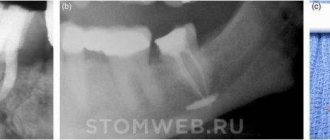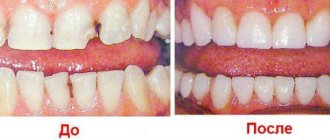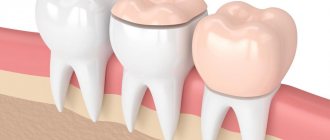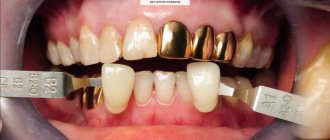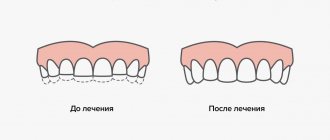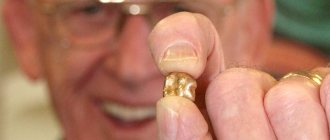Advantages of glass ionomer cement
By choosing fillings made from this material, you get:
• guarantee of complete safety for dentin and pulp. This type of cement does not emit any toxins, does not react with tooth and oral tissues, and does not cause allergies; • a noticeable reduction in the price of treatment. Availability and relative cheapness; • glass ionomer cement can significantly reduce the overall cost of caries treatment; • increased adhesion. The cement adheres well to the tooth tissue, which ensures complete immobility and tightness of the filling; • additional therapeutic effect. After installing a cement filling, it releases fluoride compounds for a long time, which strengthen the tooth and improve its condition; • low thermal conductivity of the material.
Pros and cons of glass ionomers in dentistry
The main advantage of GIC is complete safety for pulp and dentin, non-toxicity of the chemical material, and its inability to cause allergic reactions. In addition, cement dental fillings reduce the cost of treatment. Serious shortcomings include:
- long hardening of cement (up to a day);
- roughness, inability to properly polish the surface;
- fragility, high shrinkage;
- short working time (cement quickly loses softness, leaving little time for the doctor to restore the correct shape of the tooth);
- unaesthetic due to unnatural colors (although for pediatric dentistry, colored fillings are rather an advantage).
Whether a glass ionomer filling is worth it depends on the specific situation. Experienced dentists work at the Dentalis clinic in Troitsk; they will assess the degree of tooth decay, take into account the patient’s financial capabilities and offer the best treatment option. For caries, time is a friend, so it is better not to aggravate the situation and contact the clinic as quickly as possible. To schedule a consultation, call or use the form below.
Disadvantages of glass ionomer cement
• long time for final hardening of the material. In some cases it can be about a day; • short working hours. In a short period of soft consistency of the material, the dentist cannot always adequately restore the chewing surface of the tooth; • surface roughness. Glass ionomer cement fillings are difficult to polish; • low aesthetics. Most glass ionomer materials are produced in colors that are not entirely typical of natural teeth. This partly contributed to the emergence of colored cements, which have become widespread in pediatric dentistry; • high shrinkage and abrasion of the material; • the need to form a cavity in the tooth with parallel walls.
How does the composite filling procedure work?
Stages of the procedure for installing a composite filling:
- Patient anesthesia.
- Cleaning teeth from caries using special dental drills, and often under a microscope.
- Installation of a composite filling, which also takes place in several stages. First, the dentist applies a special gel to the tooth to prepare its surface for bonding with the composite. After washing off the gel, the cavity is dried and lubricated with another special liquid, the so-called bond, which is exposed to a polymerization lamp and hardens. On the base prepared in this way, the dentist places several layers of composite filling, which are irradiated each time for proper hardening.
- The final stage of treatment is to adjust the filling to the patient’s bite—grinding.
Correct installation of a composite filling is a guarantee of a beautiful smile. But most of all, it guarantees the patient’s health. The dentist must choose the right filling material that will match the structure of the tooth and its location in the oral cavity, thereby providing complete comfort to the patient.
Features of the use of glass ionomer cement
Glass ionomer cements are most often used in pediatric dentistry, as they are unpretentious to difficult placement conditions. This type of material is used to fill carious cavities and seal the fissures of recently erupted permanent teeth.
In adult dentistry, glass ionomers are used for permanent fillings, as an insulating lining for more aggressive types of materials, and for fixation of orthopedic fixed structures (crowns and bridges). Also, in some cases, glass ionomer cements are used for filling root canals.
Filling teeth with glass ionomer cement is possible only if indicated. Using them in other situations, guided only by the desire to save on treatment, means creating a serious risk of rapid destruction of the filling and the occurrence of a relapse of the inflammatory process inside the tooth.
Glass ionomer cements as a link between composite and dentin
L. A. Lobovkina , Candidate of Medical Sciences, Head of the Treatment and Prevention Department of the Federal State Budgetary Institution “12 CDC” of the Russian Ministry of Defense (Moscow)
A. M. Romanov Candidate of Medical Sciences, Chief Physician of the Implamed JSC Clinic (Moscow)
Currently, composite materials and adhesive restoration technologies are widely used in almost all clinical situations. Despite their high mechanical strength, abrasion resistance, aesthetics and good adaptation to cavity walls, composites have a number of disadvantages, including polymerization shrinkage and deformation of large-volume fillings over time, insufficient biocompatibility with hard dental tissues, lack of a cariesstatic effect, high cost [ 1].
In addition, taking into account the peculiarities of the anatomical structure of dentin and its insufficient mineralization, composites are not recommended for use in children and adolescents (under 14 years of age).
It is well known that when restoring teeth with composite materials, reliable and long-term adhesion to the enamel is not a problem and is achieved using the etching technique developed by Buonocore. However, reliable bonding between composite and dentin remains problematic [2]. The use of glass ionomer cements (GIC) as a link between dentin and composite has been intensively studied in recent years and has proven a high degree of reliability [5].
One of the fundamental differences between glass ionomer cements and composite materials is the mechanism of adhesion to tooth tissue. Using a composite, it is possible to achieve only micromechanical adhesion of the material to dentin or enamel, while glass ionomer cement forms a complete chemical compound with them.
This is achieved due to the presence of bioactive polyacrylic acid in the material, which causes ion exchange between the cement and adjacent tooth tissues [1].
Our foreign colleagues, who are skeptical about glass ionomer cements, are faced with small-sized cavities in the chewing teeth, as their patients regularly undergo preventive examinations.
In our country, patients often turn to the dentist either in the presence of an extensive carious cavity, or already in the presence of pain. Therefore, in some cases, the use of sandwich technology is more preferable than adhesive technology.
Indications for sandwich technology:
- patients who have a low level of hygiene and are susceptible to caries;
- restoration of large carious cavities, especially in pulpless teeth;
- filling defects in non-carious lesions of hard dental tissues;
- filling when it is impossible to achieve absolute dryness of the carious cavity.
Clinical example No. 1
Patient L., 23 years old, came to the dental clinic with complaints of the presence of a carious cavity and periodic pain, aggravated by the action of temperature stimuli in the area of the 3.7 tooth. After conducting basic and additional research methods, a diagnosis was made: tooth 3.7—chronic pulpitis.
First, endodontic treatment was performed on tooth 3.7 (Fig. 1). Considering that the patient had a low level of resistance of hard dental tissues, as well as a significant cavity volume and previous tooth depulpation, a sandwich technique was chosen to restore the coronal part of the tooth [3].
Rice. 1. Tooth 3.7 after endodontic treatment.
After medicinal treatment of the cavity with a 2% chlorhexidine solution, a base gasket made of double-curing GIC “Ionolux” (VOCO, Germany) was applied (Fig. 2). Ionolux combines glass ionomer and composite parts, which provides its excellent properties. Due to the composite component, the material’s aesthetic qualities have improved, the possibility of immediate finishing immediately after polymerization has become possible, the formation of a chemical bond with composites and very low solubility in water have been noted. Unlike its analogues, when working with Ionolux, there is no need for adhesive preparation of hard dental tissues (for example, there is no stage of priming of hard tissues, which is mandatory for Vitremer): it is a self-adhesive cement. It is well known that the more curing mechanisms GIC has, the less fluoride ions it releases into surrounding tissues. However, in terms of the release of fluorine ions, Ionolux is not inferior to classical GIC.
Rice. 2. A gasket made of GIC “Ionolux” was applied.
Ionolux cures within 20 seconds. Next, adhesive preparation of the cavity was carried out according to the traditional protocol. The tooth restoration was completed using the Grandio nanohybrid composite (VOCO) (Fig. 3). After removing the rubber dam, macro- and microcontouring of the restoration was performed. For this purpose, discs of various grain sizes OptiDisk (Kerr), peak-shaped and flame-shaped diamond burs of low and ultra-low abrasiveness (SSWhite) were used. The restoration was then polished using Dimanto universal polishing heads (VOCO) with air-water spray without polishing paste (Figs. 4, 5).
Rice. 3. Tooth 3.7 at the stage of restoration using the Grandio nanohybrid composite.
Rice. 4. Tooth 3.7: finishing.
Rice. 5. Tooth 3.7 after restoration.
Clinical example No. 2
Patient G., 59 years old, complained of an aesthetic defect and pain in the area of 2.2 and 2.3 teeth under the influence of chemical and temperature stimuli (Fig. 6).
Rice. 6. Initial clinical situation. Teeth 2.2 and 2.3: cement caries.
The patient was offered restoration of teeth 2.2 and 2.3, to which she agreed. It was also recommended to undergo orthopedic treatment due to the absence of a large number of teeth.
The choice of color shades was preceded by mechanical cleansing of the vestibular surface of the tooth, symmetrical to the one being restored, and adjacent teeth using a brush and fluoride-free paste. Next, the color was selected by comparing the color scale included in the set of materials with the shade of the teeth. When performing this stage, the conditions of the optimal light-color environment were observed.
After anesthesia, preparation of defects in teeth 2.2 and 2.3 was carried out with pear-shaped and spherical burs. To ensure a smooth transition of the material, a bevel of the enamel was created towards the cutting edge using fine-grained flame-shaped burs (with red or yellow stripes) (Fig. 7). After medicinal treatment of the formed cavities, glass ionomer cement “Ionolux” was added as a base liner (Fig. 8). Next, adhesive preparation of hard dental tissues was carried out according to the traditional protocol. The self-etching bond “Futurabond HP” (VOCO) was used as an adhesive, the peculiarity of which is that it releases fluorides and thereby prevents the development of “secondary” caries.
Rice. 7. Teeth 2.2. and 2.3 after preparation.
Rice. 8. Tooth 2.3: glass ionomer cement “Ionolux” was added.
After this, restoration of the anatomical shape of the teeth was carried out using the nanohybrid composite material “Grandio” (Fig. 9). Note that the Grandio nanohybrid composite is free from a number of disadvantages inherent in most composite materials. It adapts well to the cavity even without the use of a high-flow composite and does not stick to instruments: this creates comfort in work. In addition, “Grandio” has good handling characteristics. It is easily introduced into the cavity, perfectly modeled, polished well, and has the highest color fastness, which is achieved due to the hydrophobic properties of the monomer: Grandio restorations do not change color for a long time under the influence of food coloring (tea, coffee, red wine, etc.). etc.), as well as cigarette smoke.
Rice. 9. Teeth 2.2 and 2.3: final appearance after restoration.
In our opinion, sandwich technology has a number of positive aspects:
- The glass ionomer layer acts as a shock-absorbing cushion under the relatively brittle composite, thereby increasing the strength and durability of fillings, especially on the occlusal surfaces of molars.
- The release of fluoride by glass ionomer helps to “compact” the hard tissues of the tooth and reduces the risk of “recurrent” caries. And covering it with a layer of composite allows you to eliminate such a disadvantage of GIC as low abrasion resistance.
- The application of a thick (base) gasket made of glass ionomer allows you to reduce the volume of the added composite material and, as a result, reduce the polymerization shrinkage of the filling, internal stress and the possibility of deformation of the filling, and reduce the consumption of expensive composite material.
- The use of a glass ionomer spacer makes it possible to increase the aesthetics of the applied filling due to the natural opacity and color of the glass ionomer (it imitates dentin well).
- In a number of clinical cases, the use of the sandwich technique is more preferable than the adhesive technique. This refers to the treatment of dental caries in patients with “problematic” oral cavity, which is associated with the ability of glass ionomer to release fluoride [4].
- The use of the sandwich technique is indicated in cases where the area of enamel at the edges of the carious cavity is insufficient to ensure reliable adhesion of the filling or when there is no enamel on some walls at all. The doctor encounters such situations when restoring defects in the neck and root of a tooth.
Thus, glass ionomer cements have taken their rightful place in the practice of dentists. And taking into account the peculiarities of the composition and physical and mechanical characteristics, as well as the experience of our clinical use of the Ionolux material, we recommend its widespread use as a filling material in the treatment of teeth in children and expanding the indications for use in adults.
- Lobovkina Larisa Alexandrovna,Candidate of Medical Sciences, Head of the Treatment and Prevention Department of the Federal State Budgetary Institution “12 CDC” of the Russian Ministry of Defense, Russia, Moscow Lobovkina LA,Head of the Department of Dental-Prophylactics of the “12 KDC” Ministry of Defense of Russian Federation, candidate of medical science, Russia, Moscow
- Saidov M.B. New restorative light-curing nanoionomer KetacN 100 from 3MESPE // DentalMarket. -2007, No. 4. - P. 57-59.
- Tishchenko V. A. Prevention is a conceptual property of GIC // DentalMarket. - 2007, No. 4. - P. 61-65.
- Basso Matteo, Manuel Juan, Nowakowska Joanna. Restoration made of coated glass ionomer cement // Problems of dentistry. -2014, No. 1. - P. 39-42.
- Mount G J. Glass-ionomer materials: In: Mount GJ, Hume WR, editors. Preservation and restoration of tooth structure.Sandgate (Old): Knowledge book and software; 2005. 163-198.
- Ngo HC, Mount G, McIntyre J, Tuisuva J, Von Dousse RJ. Chemical exchange between glass-ionomer restorations and residual carious dentine in permanent molars: an in vivo study. JDent. 2006 Sep; 34 (8): 608–13.
Romanov Alexey Mikhailovich, k.m. Sc., chief physician of the clinic JSC “Implamed”, Russia, Moscow
Dr. Alexey Romanov, MS Ph.D. Chief Dentist OAO “IMPLAMED”, Russia, Moscow
109377, Moscow, st. Academician Scriabin, 3
Tel.
e-mail:lobo
Annotation. Over the years, composite materials and adhesive restorative technologies have been widely used in almost all clinical situations. While reliable and long-term adhesion to enamel is not a problem and is achieved using the etching technique, a reliable bond between the composite and dentin remains problematic. The use of GIC as a link between dentin and composite has been intensively studied in recent years and has proven a high degree of reliability.
Annotation. For many years, most all clinical situations, widely used composite materials and adhesive technology of restoration. If reliable and long-term adhesion to enamel is not an issue and is achieved using techniques of etching, the secure connection between the composite and dentine remains problematic. The use of glass ionomer as a binder between the dentin and composite has been intensively investigated in recent years and proves high reliability.
Key words: nanohybrid composite; glass ionomer cement; sandwich technology; extensive carious cavities.
Keywords: nanohybrid composite; glass ionomer; sandwich technique; extensive carious cavity.
Literature
Popular dental materials
Fillings are divided into permanent and temporary. A permanent one is placed when there is minor damage to the tooth crown, a temporary one is used for long-term complex treatment or diagnostics. A temporary filling is also used to protect medicinal compounds during dental treatment: a medicinal compound is placed under it.
The materials from which fillings are made are divided into several types:
- cement, silicate;
- plastic;
- metal, amalgam;
- ceramics;
- composites.
Depending on the material used, fillings are divided into several main types:
- cement;
- composite;
- compomers.
The dental industry also produces other types of fillings - plastic, metal and ceramic.
The most durable material is made from light-curing composite. Such fillings are expensive, but the high price justifies the long service life. The fillings look aesthetically pleasing and have the ability to change their shade with changes in lighting.
The most popular material is dental cement. These fillings are still in demand among patients due to their low cost, high adhesion and strength. The fillings literally stick to the surface of the crown and do not form air gaps.
Materials for filling teeth
Fillings, that is, dental fillings, are made from various materials, which must be completely safe for the patient’s health, durable and aesthetic. Amalgam fillings have been used in dental offices for many years. Because amalgam is a mixture of mercury and other metals, it has been shown to be harmful to the health of patients. The silver or black color of the filling was also not aesthetically pleasing.
Today, modern dental clinics, including Dentik +, use other materials, including: • composite resins - light-curing tooth-colored fillings, less durable than amalgam, • ionomer cements - easily adhere to the tooth, but the white color limits them usage. , • gold is a durable filling, which, however, is not popular due to the lack of color matching.
Why use dental fillings?
Regardless of whether the tooth was mechanically damaged or as a result of caries, it must have a filling. The absence of a filling exposes the tooth to external factors. This, in turn, leads to further destruction and exposes the patient to pain.
When caries is advanced, pulpitis appears, which in turn leads to health problems. In such situations, endodontic treatment (root canal treatment) is necessary, which is more invasive and expensive than simply installing a filling.
Untreated teeth negatively affect the entire body. The bacteria that spread after it can disrupt the functioning of very important internal organs, including the heart and kidneys. This is a very serious problem, so the use of a dental filling is necessary. Even small cavities can quickly turn into much larger problems.
Plastic, metal and ceramic compounds
Plastic fillings are also at the peak of popularity, also due to their low price. Plastic has many disadvantages:
- gives significant shrinkage after curing;
- changes its color over time;
- quickly wears out and becomes unusable;
- poorly protects against secondary caries.
Important! Cement and plastic fillings are placed in free dental clinics.
Ceramic compositions
The distinctive characteristics of this material are high strength, lack of shrinkage and aesthetics. Ceramics does not darken during use and is not painted. In modern dentistry, ceramics is considered an almost ideal filling material. Types of ceramics include:
- transparent material;
- pressed material;
- metal ceramics.
The disadvantages include the difficulty of installation: the composition fills the hole in the tooth, like an inlay. The inlay is formed using an impression of a previously sanitized tooth.
Metal alloys
Amalgam material includes a mercury compound along with silver. The dangers of exposure to mercury in the body pose a certain health risk. The advantage of amalgam is its long service life and abrasion resistance.
Another disadvantage of this material is expansion during hardening. If the dentist does not correctly calculate the volume of the filling, the possibility of slight destruction of the crown cannot be ruled out.
Due to the unaesthetic appearance of metal structures, they are used on back teeth or the hidden surface of the crown.
What is a dental filling?
A dental filling is a filling of a tooth that involves its reconstruction or restoration. At the dental clinic “Dentik +” in Ryazan, various tools and materials are used for filling. By filling a tooth, our doctors strive to preserve the health of the tooth and give it the opportunity to function normally. By placing dental filler, the tooth will eliminate the need for extraction.
The reason for filling a tooth is its mechanical damage or carious defect. First, the dentist cleans the tooth of biological debris and then seals it, that is, seals the tooth. The procedure can be performed under local anesthesia, although not all patients require it.
Does tooth filling hurt?
Pain is the most common factor that prevents patients from visiting the dentist. Even such a simple procedure as filling a tooth can be associated with very serious discomfort. The truth is that it very much depends on the individual patient. Some people are more sensitive to pain and find the sealing procedure very unpleasant. In other cases, patients experience only slight discomfort or nothing at all. Despite everything, modern dentistry offers treatment under anesthesia, so pain is not a problem today.
